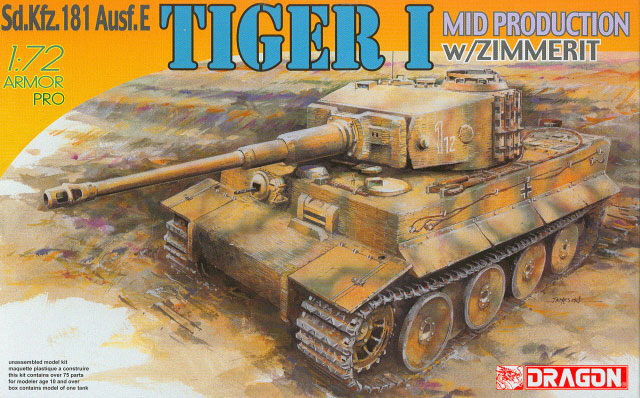|
|
|
|
| Home > Reviews > Small Scale > Dragon 1/72 Sd. Kfz. 181 Ausf. E Tiger I Mid Production w/Zimmerit (7251) |
Sd. Kfz. 181 Ausf. E Tiger I Mid Production w/Zimmerit
Reviewed by Cookie Sewell

Summary
| Stock Number and Description | Dragon Models Limited 1/72 Scale Armor Pro Series Kit No. 7251; Sd. Kfz. 181 Ausf. E Tiger I Mid Production w/Zimmerit |
| Scale: | 1/72 |
| Media and Contents: | 86 parts (57 in grey styrene, 24 etched brass, 2 pre-formed brass, 2 tracks in tan DS plastic, 1 section of twisted steel wire) |
| Price: | retail price estimated at US $13.95 |
| Review Type: | First Look |
| Advantages: | Simplified version of Late Production kit with different molding and etched brass with the zimmerit paste application molded into the plastic |
| Disadvantages: | Some parts simplified, e.g. tools molded in place, one or two bad seams may be hard to align |
| Recommendation: | Highly Recommended for beginning modelers and small-scale German armor fans |
FirstLook
This is one of the better series of kits being released by DML right
now. If you model German armor, especially the mid-war items that
left the factory with the "Zimmerit" concrete paste on them to
attempt to defeat Soviet magnetic mines and grenades, then you know
that for years you have had to do it the hard way.
This is DML's second Tiger I kit with zimmerit paste applied. As
such, all parts come with the surfaces engraved to represent the
coating and appear to be very nicely done. (Realize in real life
this coating was only about 3-6 mm thick on average, which amounts
to about 0.04-0.08 mm in this scale.) The zimmerit is represented on
the lower hull front, sides, rear plate, turret sides and mantelet,
and upper hull glacis. All of these parts are new to the earlier
"clean" Tiger kit and totally replace them.
The only bugaboo may be getting a good seam at the rear of the
turret, but with some judicious use of a good slow-drying liquid
cement like Testor's and a good Xacto knife, the seam should be easy
to conceal.
As with other recent DML kits, it has a great deal of "slide-molded"
parts. All of the running gear comes down to only four parts per
side – drivers (one piece), idlers (one piece), and road wheels
(nesting inner and outer sections interleaved and held together by
styrene bands.) It also has a hollow-molded 8.8 cm gun muzzle brake
and other niceties.
Unlike the first kit of this type – No. 7203 – this one comes with a
24 piece etched brass fret and pre-formed brass exhaust shrouds, as
well as other niceties. But there is no option about using them if
you want an accurate model. (Note that the "Armor Pro" series of
1/72 scale kits is an upgraded one which is designed for modelers
who want more accurate kits with the "goodies" included.) All of the
grille work is included, and while the "box" for an engine and
radiator section is included it is not listed in the instructions
nor is there any interior provided for it. The kit's engine deck
comes sealed with open louvers but that is it. The brass also
includes a number of very tiny brackets and tie-downs for the
molded-on tools to at least dress them up, as well as the hatch seal
ring for the commander's cupola.
The kit also ditches the first kit's black vinyl tracks in favor of
the now-standard DS plastic ones in this scale, which will help
modelers get the "sag" right by being able to simply cement them to
the top of the wheel runs.
The model still has holes in the belly for attaching the model to a
base, such as the pre-assembled kits.
This looks an even easier-to-build model than the first Tiger I with
zimmerit, and the only complaint I foresee from some more serious
modelers is the fact that the shovel and other small bits are molded
in place on the top of the hull. It does, however, include a scale
thickness steel cable for the tow cables.
Four finishes are suggested: 2./s.Pz.Abt. 510, Kurland, Eastern
Front 1944 (tricolor); the popular "charging knight" scheme of 3/s.Pz.Abt.
505, Nowe Koszary 1944; s.Pz.Ab. 502, Malinava, Latvia 1944; and 2./s.Pz.Abt.
510, Kurland, Eastern Front 1944 (two-color.) in Normandy, June
1944, and s.Pz.Abt. 101 in Normandy, July 1944.
In summary, this release continues the incremental improvements and
"fine tuning" by DML in their small scale kits and one that should
be well received, especially among new modelers not sure as to how
to best replicate zimmerit. It also cries out for drybrushing!
Highly Recommended.
Thanks to
Freddie Leung for the review sample.
Text and Images by
Cookie Sewell
Page Created 28 August, 2006
Page Last Updated
27 August, 2006
